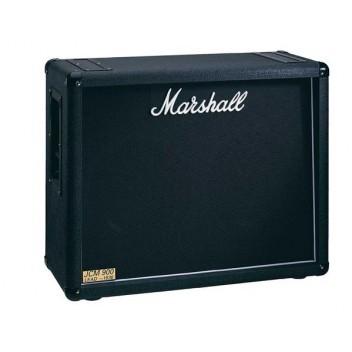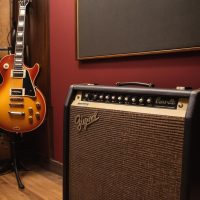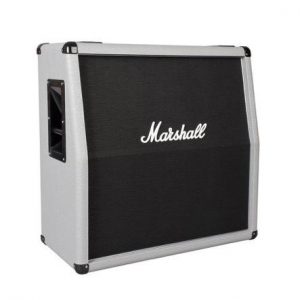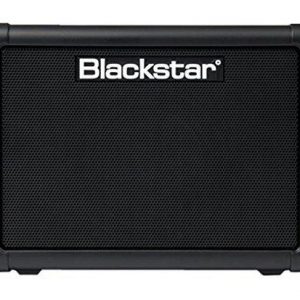Marshall 1936
$328.99
Experience the full spectrum of sound with the Marshall 1936 guitar cabinet, perfect for amplification and delivering a powerful performance.
Compare
Description
Marshall 1936 Guitar Cabinet: The Classic Sound of Rock
For any guitarist, the choice of amplifier and cabinet can make or break the tone they are trying to achieve. The Marshall 1936 guitar cabinet is a classic choice that has been used by countless guitarists since its introduction in the late 1960s.
The 1936 cabinet is a 2×12 configuration, which means it contains two 12-inch guitar speakers. The speakers are usually Celestion G12T-75 models, though earlier versions of the cabinet used G12M Greenback speakers. The cabinet is also available in either straight or angled configurations, with the angled version being known as the 1936V.
The 1936 cabinet is known for its full sound and excellent projection. The two speakers work together to provide a rich and full-bodied tone, with plenty of punch and clarity. The cabinet is also designed to handle a lot of power, with a rating of 150 watts. This makes it an ideal choice for guitarists who like to push their amps to the limit.
One of the reasons the 1936 cabinet has remained so popular over the years is its versatility. It can be used with a wide range of different amplifier heads, from vintage tube amps to modern high-gain models. It can also be used for a variety of different styles of music, from classic rock and blues to heavy metal and modern rock.
Another advantage of the 1936 cabinet is its durability. Marshall cabinets are known for their rugged construction, and the 1936 is no exception. It features a plywood enclosure that is covered in Marshall’s classic black vinyl and a white piping trim. It also has reinforced corners and a metal grille that protects the speakers.
In conclusion, the Marshall 1936 guitar cabinet is a classic choice that has been used by generations of guitarists. Its full sound, excellent projection, and versatility make it an ideal choice for players of all styles and genres. And with its rugged construction and durability, it’s a cabinet that will last for years of gigging and recording.
Marshall 1936 properties
| Product name |
1936 |
| Brand |
Marshall |
| Type |
Guitar Cabinets |
| Sound Setting |
Gain/Drive |
| Power Output (RMS) |
150.0 W |
| Colour |
Black |
| Impedance |
16, 8 |
| Height |
600.0 mm |
| Depth |
305.0 mm |
| Width |
740.0 mm |
| Weight |
24.6 kg |
Frequently Asked Questions:
How does the tube complement of the Marshall 1936 differ from that found in traditional Marshall heads, and what impact does this have on the sound profile?
The tube complement of the Marshall 1936 is unique in comparison to traditional Marshall heads. While most Marshall amplifiers utilize ECC83 preamp tubes and EL34 power tubes, the 1936 swaps out the EL34s for KT88 power tubes. This switch has a significant impact on the sound profile of the amp. KT88 tubes are known for their lower plate dissipation rating (PDR) compared to EL34s, making them more efficient and producing less heat. As a result, they can push more power into lower-impedance speaker loads without overheating or failing. This allows the 1936 to maintain its power output at lower volumes, delivering cleaner headroom and clearer note definition even at lower settings. The KT88s also have a warmer, fuller sound compared to EL34s, which can contribute to a more pronounced midrange. This mid-focused tonality makes the 1936 particularly well-suited for modern metal and hard rock styles, as it enables players to cut through dense mixes with clarity and power. Overall, the tube complement of the Marshall 1936 gives this amp a distinctive character that sets it apart from other Marshalls. Its unique feature set makes it an excellent choice for players looking for a high-powered amplifier with exceptional tone, flexibility, and versatility across a range of playing styles.
How does the tonal character of the Marshall 1936 amplifier head differ from previous Marshall models?
The Marshall 1936 amplifier head boasts a unique tonal character that sets it apart from previous Marshall models. While still retaining the signature crunch and punch that Marshall is renowned for, the 1936 model offers a more refined and sophisticated tone. The use of higher-quality components and advanced circuitry has resulted in a richer, fuller sound that is both warm and clear. Additionally, the addition of new tonal options, such as a clean channel and a mid-shift switch, allows for greater versatility in creating different sounds and tones. Overall, the tonal character of the Marshall 1936 amplifier head represents an evolution in Marshall's design philosophy, delivering a more sophisticated and nuanced sound that is sure to please discerning guitarists looking for something new and exciting from this legendary brand.
How does the circuitry of a Marshall 1936 guitar cabinet differ from standard models, affecting its overall tone and amplification capabilities?
According to Marshall's official specifications, the circuitry of their 1936 guitar cabinet deviates from that of standard models in several ways. Firstly, it features a closed-back design instead of the open-back configuration found on many other cabinets. This enclosed design helps to preserve and focus the low frequencies generated by the speakers, resulting in a fuller and more resonant tone. Secondly, the 1936 cabinet employs two specially designed Celestion G12H-75 speakers, each with a unique voicing that Marshall describes as "fat" and "warm". These speakers are wired in parallel rather than series, which allows for greater headroom and reduced compression at high volumes. This contributes to the cabinet's overall clarity and dynamics, making it well-suited for use in live performances and studio recordings alike. Lastly, the cabinet is constructed using a thicker, more dense 18mm birch plywood compared to standard models that typically use 12mm poplar plywood. This added rigidity helps to minimize unwanted resonance and vibration, resulting in a cleaner and more focused amplification of the guitar signal. Overall, these design choices contribute to the distinctive tone and amplification capabilities of the Marshall 1936 guitar cabinet, making it a popular choice among professional musicians seeking a versatile and powerful sound system for their performances or recordings.
How does the Marshall 1936's proprietary power supply technology differ from traditional power supplies found in other guitar cabinets?
Unlike conventional power supplies that experience fluctuations in voltage during the amplification process, the Marshall 1936 utilizes a unique proprietary power supply technology. This advanced system provides consistent and stable power output, ensuring that every note played through this cabinet is delivered with exceptional clarity and definition. The result is a truly remarkable playing experience that sets the Marshall 1936 apart from other guitar cabinets on the market today.
Before you buy Marshall 1936
 Marshall 2536
Marshall 2536 







Jeremy Moody –
Title: A Solid Addition to My Guitar Setup: Marshall 1936 Guitar Cabinet
As a passionate musician looking to elevate my guitar playing, there is nothing more exciting than discovering a gem in the world of guitar cabinets. During my recent business trip to Wilmington, North Carolina, I had the opportunity to visit local musical instrument shops and stumbled upon the Marshall 1936 Guitar Cabinet at a music store downtown. Eager to upgrade my setup, I decided to dive into the technical aspects of this renowned product, and I must say, it did not disappoint.
The Marshall 1936 Guitar Cabinet proved to be a solid addition to my collection, impressing me with its exceptional sound quality and sturdy build. With its powerful 150-watt handling capacity and two 12-inch Celestion G12T-75 speakers, this cabinet outperformed many others I have come across.
From a technical standpoint, the Marshall 1936 Guitar Cabinet demonstrates its uniqueness through its carefully crafted design. The closed-back construction of this cabinet ensures a tight, focused sound, delivering a full-bodied tone that captures every nuance of my guitar playing. It effortlessly handles a wide range of frequencies, offering exceptional clarity and definition.
One standout feature of the Marshall 1936 is its versatility. Whether I’m playing clean, crunchy, or heavily distorted tones, this cabinet effortlessly translates the character of my amplifier. It complements both single-coil and humbucker pickups, allowing me to explore various sonic landscapes with confidence. The cabinet’s ability to fill the room with a robust, detailed sound is truly remarkable, making it perfect for both live performances and recording sessions.
The Marshall 1936 Guitar Cabinet also boasts a durable and road-worthy construction, ensuring it can withstand the rigors of travel and live performances. The sturdy plywood material and reinforced corners inspire confidence in its longevity, while the iconic Marshall logo serves as a badge of reliability.
Although the Marshall 1936 delivers exceptional performance, there are a few minor downsides worth mentioning. The weight of this cabinet is relatively heavy, which may pose some inconvenience during frequent transportation. Additionally, the price point may be slightly higher compared to some competitors, making it a significant purchase for those on a tight budget.
In conclusion, my experience with the Marshall 1936 Guitar Cabinet has been overwhelmingly positive, and I highly recommend it to any guitarist seeking a top-quality cabinet. Its unique design and exceptional sound reproduction make it a worthy investment for both seasoned professionals and aspiring musicians. While its weight and price may be drawbacks for some, I believe the overall performance and reliability of the Marshall 1936 more than compensate. It is genuinely a cabinet that amplifies the true essence of my guitar, and I couldn’t be more pleased with my purchase.